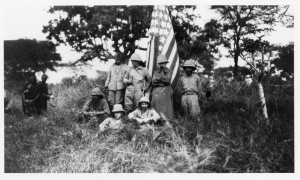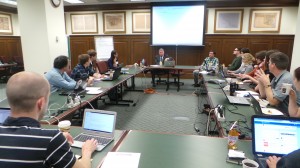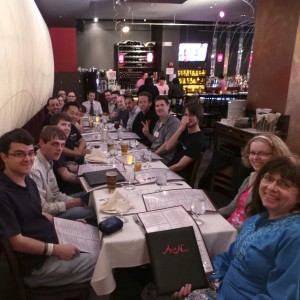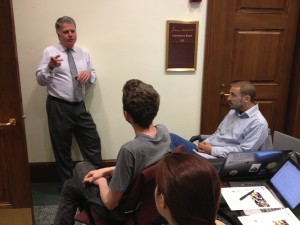Smithsonian Field Notes and Wikipedia
Posted by James on June 27th, 2013

Former President Theodore Roosevelt (1858-1919) and other members of his expedition party from the Smithsonian Roosevelt African Expedition stand next to an American flag. Courtesy of the Smithsonian Institution Archives.
Wikimedia DC has hosted several edit-a-thons with the Smithsonian Institution over the past several months, including the Civil War and American Art Edit-a-Thon and Women in the Arts 2013. Our latest event with the Institution focused on the Smithsonian Institution Archives’ collection of field notes. Effie Kapsalis, who organized the workshop, wrote an excellent summary on the Archives’ blog:
This past Friday, we held our 3rd Wikipedia edit-a-thon on the scientific field books in the Smithsonian Institution Archives’ collections (field books are primary source documents that describe the events leading up to and including the collection of specimens or observations during field research). All told, we had 18 volunteers who donated their entire Friday to work on articles related to explorers and expeditions held in our collections. Amongst the 18 were a husband/wife team, and a father-daughter team.
Participants gathered over coffee in the morning to hear more about the Archives and the Field Book project, a partnership between the Archives and the National Museum of Natural History which seeks to create a single online location for scientific field books. The talk was followed by a tour of the Russell E. Train Africana Collection, a special collection housed in the Smithsonian Institution Libraries which contains several thousand manuscripts, photographs, original artwork and prints, posters, maps, ephemera, and man-made and natural artifacts relating to exploration, big game hunting, wildlife, and travel in Africa dating from 1663 to the late 1990s. The tour provided rich context for one of the articles on our to-do list, the Smithsonian-Roosevelt African Expedition.
After lunch, we got down to business and worked on our to-do list for the remainder of the afternoon. I am happy to report that as a group, we worked on all but one of the items on the to-do list. Even better, each explorer/scientist or expedition received attention from more than one, if not several, Wiki editors which makes for a stronger article in the end. Here is a list of the people that now have Wikipedia articles as a result of this gathering:
-
Theodore Roosevelt on African Expedition, by Unknown, 1909, Smithsonian Archives – History Div, SIA2009-1371 and SA-943.
Argentinian botanist, Cleofé Elsa Calderón who rediscovered Anomochloa, a genus of grass, which led to a detailed morphological and anatomical study that confirmed it as a grass. Calderón also has a genus of grass names for her, Calderonella.
- Mammologist and field naturalist, John Alden Loring, who served on several expeditions collecting specimen in North America, Europe, and Africa.
- Ornithologist, James Eike, President and long-standing executive committee member of the Virginia Society of Ornithology and creator of over 111 field books.
- The Smithsonian-Roosevelt African Expedition, an expedition organized by then U.S. President, Theodore Roosevelt, which amassed over 23,151 natural history specimens.
If you’d like to contribute, we could use your help expanding the articles on the Explorers & Expeditions to-do list. If you’d prefer to start fresh on a new Wikipedia article, we have on our main to-do list from past edit-a-thons which needs some attention and care from volunteers like you. In any case, next time you cite a Wikipedia page for information, remember the many hands that went into creating and editing that page.
Much thanks to Effie and her colleagues for organizing the workshop, as well as to the National Museum of Natural History for hosting! Be sure to check out the Smithsonian’s to-do list for Wikipedia articles and dive right in. If you would like an experienced Wikipedia editor to guide you along, check out one of our upcoming events and feel free to ask. We’re happy to help!

Former President Theodore Roosevelt (1858-1919) and other members of his expedition party from the Smithsonian Roosevelt African Expedition stand next to an American flag. Courtesy of the Smithsonian Institution Archives.
Wikimedia DC has hosted several edit-a-thons with the Smithsonian Institution over the past several months, including the Civil War and American Art Edit-a-Thon and Women in the Arts 2013. Our latest event with the Institution focused on the Smithsonian Institution Archives’ collection of field notes. Effie Kapsalis, who organized the workshop, wrote an excellent summary on the Archives’ blog:
This past Friday, we held our 3rd Wikipedia edit-a-thon on the scientific field books in the Smithsonian Institution Archives’ collections (field books are primary source documents that describe the events leading up to and including the collection of specimens or observations during field research). All told, we had 18 volunteers who donated their entire Friday to work on articles related to explorers and expeditions held in our collections. Amongst the 18 were a husband/wife team, and a father-daughter team.
Participants gathered over coffee in the morning to hear more about the Archives and the Field Book project, a partnership between the Archives and the National Museum of Natural History which seeks to create a single online location for scientific field books. The talk was followed by a tour of the Russell E. Train Africana Collection, a special collection housed in the Smithsonian Institution Libraries which contains several thousand manuscripts, photographs, original artwork and prints, posters, maps, ephemera, and man-made and natural artifacts relating to exploration, big game hunting, wildlife, and travel in Africa dating from 1663 to the late 1990s. The tour provided rich context for one of the articles on our to-do list, the Smithsonian-Roosevelt African Expedition.
After lunch, we got down to business and worked on our to-do list for the remainder of the afternoon. I am happy to report that as a group, we worked on all but one of the items on the to-do list. Even better, each explorer/scientist or expedition received attention from more than one, if not several, Wiki editors which makes for a stronger article in the end. Here is a list of the people that now have Wikipedia articles as a result of this gathering:
Argentinian botanist, Cleofé Elsa Calderón who rediscovered Anomochloa, a genus of grass, which led to a detailed morphological and anatomical study that confirmed it as a grass. Calderón also has a genus of grass names for her, Calderonella.
- Mammologist and field naturalist, John Alden Loring, who served on several expeditions collecting specimen in North America, Europe, and Africa.
- Ornithologist, James Eike, President and long-standing executive committee member of the Virginia Society of Ornithology and creator of over 111 field books.
- The Smithsonian-Roosevelt African Expedition, an expedition organized by then U.S. President, Theodore Roosevelt, which amassed over 23,151 natural history specimens.
If you’d like to contribute, we could use your help expanding the articles on the Explorers & Expeditions to-do list. If you’d prefer to start fresh on a new Wikipedia article, we have on our main to-do list from past edit-a-thons which needs some attention and care from volunteers like you. In any case, next time you cite a Wikipedia page for information, remember the many hands that went into creating and editing that page.
Much thanks to Effie and her colleagues for organizing the workshop, as well as to the National Museum of Natural History for hosting! Be sure to check out the Smithsonian’s to-do list for Wikipedia articles and dive right in. If you would like an experienced Wikipedia editor to guide you along, check out one of our upcoming events and feel free to ask. We’re happy to help!


